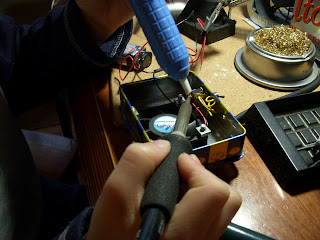A friend of mine recently asked my advice. Apparently his twelve year old nephew is turning out to be "quite the geek". As my friend described his nephew's love to take stuff apart and make something new with it, I could tell we had the beginnings of a fine young maker.
The challenge is that the boy's parents are not necessarily so technical. They know that he built something out of an Xbox and laptop, but they cannot begin to explain what it is. They've tried to support him by getting him some kits from Radio Shack, but he wasn't really challenged by them.
My friend turned to me for some suggestions for challenging kits that would not "do any damage to the house". So here is my list of...
Resources for Young Makers
#1: Let's Make Robots
Being a robotics enthusiast myself, I had to lead with the Let's Make Robots website. If you think your own young maker would like robots, this is a great place to start. Joining Let's Make Robots is free and they do have some younger members. There are lots of supportive people and example projects on the site, such as the Start Here robot project, pictured below.#2: MAKE Magazine
MAKE is another good resource. They have subscription print and online versions, as well as free projects posted on the Make Projects website. They also sell kits and parts at the Maker Shed. Projects and articles are organized by topic; there's something for everyone.#3: Instructables
Another great website is Instructables. This is a free site with loads of projects. Just about anything you can imagine, all submitted by members.
Since the content is member-submitted, the quality does vary a bit. There are many very good step-by-step projects, listing parts and materials needed.
Instructables even runs contests to encourage makers to share their knowledge.
Projects are organized into various topics, and the whole site is a searchable wealth of collected practical knowledge.
#4: Adafruit
Another wonderful company is Adafruit. They are an open source hardware electronics company, with a strong social network. Adafruit was started by Limor Fried (aka Ladyada), pictured on the cover of Wired Magazine to the left.
Limor started the company to create a "place online for learning electronics and making the best designed products for makers of all ages and skill levels." That's an admirable goal, and they are a driving force in today's maker movement.
Adafruit specifically created some skill badges for young people at the Adafruit Academy. The badges are like Scouting badges, except on subjects like soldering, using a multimeter, programming, and much more.
There is also the Lady Ada website, which includes projects and resources to help you make stuff.
#5: DIY.org
Another site is diy.org. Kids can join (with parents' assistance) and do projects and challenges to earn skill badges.Unlike Instructables, MAKE, or Adafruit, the whole site is designed around kids.
They even created a video "Anthem", encouraging kids not only to build, make, hack and grow, but also to share what they learned with others on the site.
There are plenty of other resources out there, far too many to list. However, I would recommend that young makers pick just one or two places to start with. Finding a good resource and a supporting maker community is the best way to start. Hopefully, something in the list above to appeal to the maker in your family.





















































